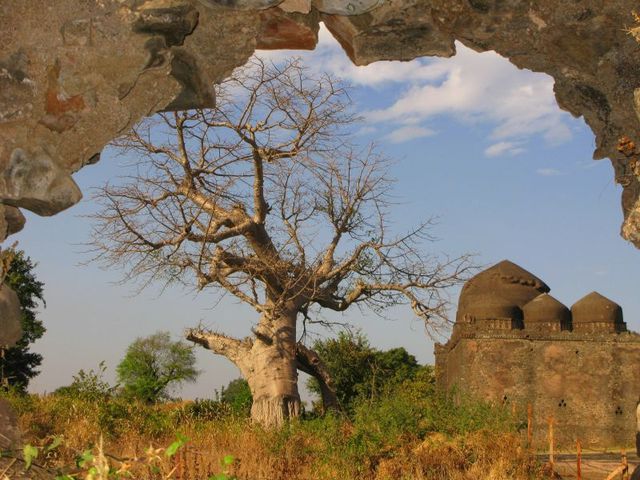Madhya Pradesh has a way of surprising you. Around every corner of this wonderful heartland of India lies a startling discovery waiting to be discovered. Even popular tourist places of MP like Mandu have hidden gems and astonishing little nuggets of data that few know about or understand. One such wonder is the enigmatic Mandu ki Imli or the Baobab Tree.
Yes.. you read it right – smack in the middle of subtropical India lies a small cache of Baobab trees that are very VERY far from home. Known to be a gift to the Kingdom of Malwa, the African Baobab Trees (Adansonia digitata) can be seen casually hanging around the quiet lanes of Mandu, completely oblivious to the fact that they don’t even belong on this continent.
Mandu is a city that is known for its walled fortress, the mysterious Jahaz Mahal, the romantic tales of Roopmati and Baaz Bahadur and the numerous archaeological places of interest that dot the ancient capital of the Malwa Kingdom. But the bulbous trunks and scraggly branches of African Baobabs are something that one would never expect to find here. Known locally as Mandu ki Imli or Khorasani Imli, these baobab trees can be found hulking over pathways, remains of ancient forts, temples and even farmland. There is no rhyme or reason to their existence in the place. And the locals have all sorts of takes as to why Mandu ki Imli or African Baobab trees are found here in Mandu – this sleepy little town in the heart of India.
The local name for the Baobab fruit is Khorasani Imli which leads one to believe it has roots in the ancient land of Khorasan (Ancient Persia). Some locals believe that the medicinal properties of the fruit, especially its ability to quench thirst, was the reason why the local rulers had it imported from Africa to manage water shortage in the region. Others cite tales of Egyptian Caliphs who gifted the baobab tree to the Sultans of Mandu.
However, to understand their existence in the land, one must first explore the tumultuous past of the city where they are found. Mandu has witnessed the rule of several kings and dynasties throughout history including the Hindu Parmars, Maratha Puars, Khiljis and even Mughals. The most commonly cited story from Mandu’s history revolves around the Ghuri Dunasty, established by the Afghans who took over the land around 1401. (Source). Locals believe that seeds of the Baobab Tree were brought to Mandu by Afghan Rulers of the Ghuri Dynasty. This was when Hoshang Shah used to rule the kingdom of Malwa.
Many local beliefs even associate the Mandu tree with mythological stories. Some speak of Lord Krishna voyaging to Africa and returning back home with the seeds to this tree. Others refer to the story of Samudra Manthan wherein the Gods and Demons came together to churn the sea and manifest many blessings like Amrit, Kaamdhenu, several gems and jewels and the Baobab tree or Kalpvriksh. Notice the stark similarities between the cultural beliefs surrounding the Baobab Tree, as they exist in African Cultures and Indian Mythology. Both regard the tree with reverence for its life giving powers, giving it the name – Tree of Life. If one set of ideologies is to be believed, the Baobab Tree is what is referred to as Parijaat or the wish bearing tree. And its only earthly manifestation is found in the Village of Kintoor, near Barabanki in Uttar Pradesh. The Harivansh Puraan talks about this tree being brought to the earth by Lord Krishna, to please his wife Satyabhaama. (Source)
Mandu ki Imli trees may not be accorded the same reverence, possibly because of the local ideologies and stories connected with it.
Historically, researchers have assumed that African Baobabs or the Mandu Imli Trees were brought to Central India by Arab traders who brought African slaves with them as part of their entourage. However, not much evidence to support these assumptions have been discovered over the years. Recent studies that delved into a genetic analysis of Mandu Baobab trees, comparing them with their African ancestors, revealed surprising details about the timelines for their introduction in India.
A research study conducted in 2015 by Karen L. Bell, Haripriya Rangan, Christian A. Kull and Daniel J. Murphy called The history of introduction of the African baobab (Adansonia digitata, Malvaceae: Bombacoideae) in the Indian subcontinent (source) found that:
The introduction of Baobabs in the Indian subcontinent took place across multiple instances throughout history, possibly even dating back to prehistoric times. The genetic analysis of these trees indicate that the trees in Mandu belong to the same species of Adansonia digitata that are found in Eastern Africa, and present less genetic diversity as compared to their counterparts. This leads one to infer that the Baobab trees in India have not been present here long enough to genetically diversify and become indigenous. However, genetic analysis also indicates the presence of private alleles (variant genes) that are not found in African Populations. This points to the fact that the introduction of these Baobabs occurred long before the assumed period of Arab trade relations and the Ghuri Dynasty’s rule on Mandu around the 1400s. When combined with the existing historical data about trade relations between East Africa and the Indian Subcontinent and cultural similarities between both regions surrounding the trees, it can be inferred that the Mandu Baobab trees were introduced by Africa Diaspora that arrived and thrived in India across various centuries.
Another study called Elusive Traces: Baobabs and the African Diaspora in South Asia by Haripriya Rangan, Karen L Bell (Source) dives further into the mystery:
The genetic study of these trees indicate that the baobabs in East African regions between Mombasa (southern Kenya) and Sofala (northern Mozambique) are closely related to the clusters found in Central India. The evidence of genetic admixtures present in the Central Indian clusters indicate that these populations experienced repeated introduction of the Baobab Tree over time, sourcing to the same cluster found in East Africa. These analyses provide a meaningful frame of reference over which one can trace the movement of African Baobab trees (Mandu ki Imli) across the Indian Ocean to inland regions like Dhar and Mandu before the rise of Islam (pre-8th century CE) and between 10th and 17th centuries.
✓ The active role of the land of Punt (Ethiopia and Somalia) in Indo-Egyptian sea trade around the second millennium BCE.
✓ Accounts of Greek Traders from 3rd century BCE, mentioning the presence of a mingling population of India, Africa, Arabia, and Persia in East Africa.
✓ The Periplus of the Erythraean Sea – an account written by a Greek Merchant in the 1st century CE that describes a busy maritime trade world between Northern and Eastern Africa, Arabia, Peninsular India (particularly Gujarat) and Sri Lanka.
✓ The arrival of other African food crops like sorghum, pearl millet (Bajra), finger millets (ragi), cowpea (chowli), hyacinth bean (sem falli), and the tamarind tree (imli) around this time.
From these indicators and genetic data, one can safely draw inferences about the history of Mandu ki Imli trees and their presence as one o the largest clusters of African Baobab Trees in India. It can be worked out that Mandu ki Imli or Mandu Baobab trees were first introduced in India about 4000 years ago by African Traders who formed transitional populations within the Indian diaspora. The Baobab tree holds immense cultural significance within African communities. Some even refer to it as the Tree of Life. One can therefore, understand why these seafaring traders from present-day Sudan, Ethiopia and Somalia, would bring Baobab fruits (which have long shelf lives, if handled correctly) to India during their travels and introduce the species, whether intentionally or unintentionally, to the Indian soil.
The historical interactions between Indian and African populations across centuries of overseas trade and commerce, still remain a poorly researched and explored topic. Most beliefs about the history of Baobab trees in Mandu or Mandu ki Imli, are centred around the assumption that they were either gifted to Malwa Kings by Khorasani Rulers or were brought to India by African slaves who travelled to India with Chinese, European or Arab traders.
Recent studies into these cultural interactions indicate, however, that Mandu Imli trees were brought to the Malwa region by free traders from Sudan, Ethiopia and Somalia via various seafaring trade routes. Genetic studies place the timeline of introduction of these species in India around the same time when other African food products like Tamarind and Cowpea found their way to India. The presence of African-Indian populations like the Siddis in Karnataka, Maharashtra, Gujarat and even Chhota Mandu (as per many locals) and the cultural and linguistic similarities between them and Indian beliefs about the Baobab tree indicate more of a relationship fostered around equality and mutual benefit through trade. However, much still remains to be explored further.
Sources:
The history of introduction of the African baobab (Adansonia digitata, Malvaceae: Bombacoideae) in the Indian subcontinent: https://royalsocietypublishing.org/doi/full/10.1098/rsos.150370#d3e1880
Elusive Traces: Baobabs and the African Diaspora in South Asia: https://www.researchgate.net/publication/273165985_Elusive_Traces_Baobabs_and_the_African_Diaspora_in_South_Asia
Pathways for introduction of Baobabs from Africa to India: https://theconversation.com/baobab-trees-trace-the-african-diaspora-across-the-indian-ocean-47467
Maritime Map depicting Indo-African Trade: https://www.discovermagazine.com/technology/the-indian-ocean-a-maritime-trade-network-history-nearly-forgot
History of Mandu: https://en.wikipedia.org/wiki/Mandu,_Madhya_Pradesh#History
Baobab as KalpVriksh: https://en.wikipedia.org/wiki/Kalpavriksha#Identification_with_other_trees
Other Useful Links:
https://whitehorsepress.blog/2018/05/02/elusive-traces-african-baobabs-in-india/
https://theconversation.com/baobab-trees-trace-the-african-diaspora-across-the-indian-ocean-47467
https://minerva-access.unimelb.edu.au/bitstream/handle/11343/115372/Rangan%20Bell%20Elusive%20traces-Revised%20EH%20Green%20Access.pdf
Image Sources:
Image 1: https://outreachecology.com/landmark/category/geography/madhya-pradesh/mandu/
Image 2: https://manishjaishree.com/मांडू-यात्रा-गाइड/
Mishi Bhatnagar, is an event coordinator and travel writer with Junoon, with a penchant for exploring unique locations and learning about their culture, history and folklore. She describes herself as a legal expert by profession (unfortunately 😦 ), a travel writer by passion and a lifetime patient of an incurable disease known as “being bitten by the Travel-Keeda“.



